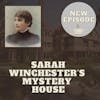Sarah Winchester's Mystery House

Sitting along the busy intersections of San Jose stands a grand mansion with a haunted past.
The Winchester Mystery House has been a top tourist destination for one hundred years and is known for its creepy design elements like the stairs to nowhere and doors that do not open. Most have heard the stories about how Sarah Winchester, a rich widow who lost her husband and daughter, visited a medium who told her to move west and build a house big enough for all who had fallen victim to the Winchester Rifle. But what if I told you that wasn't the real story? Tune in to learn the truth about Sarah Winchester and her mystery house.
SOURCES
Carter, Maria. “Winchester Mystery House: The Bizarre True Story - New Movie About the Winchester House. Country Living Magazine. January 24, 2018. (LINK)
Dowd, Katie. “Everything you think you know about the Winchester Mystery House probably isn’t true.” SFGate. Updated February 6, 2018. (LINK)
Haag, Pamela. “The Heiress to a Gun Empire Built a Mansion Forever Haunted by the Blood Money That Built It.” Smithsonian Magazine. July 7, 2016. (LINK)
Ignoffo, Mary Jo. Captive of the Labyrinth: Sarah L. Winchester, Heiress to the Rifle Fortune. United States: University of Missouri Press, 2010.
Pizarro, Sal. “Sarah Winchester still fascinates us 100 years after her death.” Marin Independent Journal. September 3, 2022. (LINK)
“Winchester House.” National Park Service. Last updated January 30, 2018. (LINK)
Welcome to Civics and Coffee. My name is Alycia and I am a self-professed history nerd. Each week, I am going to chat about a topic on U.S history and give you both the highlights and occasionally break down some of the complexities in history; and share stories you may not remember learning in high school. All in the time it takes to enjoy a cup of coffee.
INTRO MUSIC
Hey everyone, welcome back.
If you’ve ever visited the greater bay area, then there are likely a few major tourist destinations you heard about and visited. There is the world famous Alcatraz, as seen in the 90s film The Rock, and of course places like the Golden Gate Bridge, Pier 39, and wine country.
And if you are into all things spooky, then you may have also heard about one of the most famous quote unquote haunted houses in California, the Winchester Mystery House.
Built by what many describe as an eccentric widow during the Gilded Age, the Winchester mansion has been a popular tourist spot since it opened its doors one hundred years ago. Even before her death and the home’s transition into a tourist destination, stories proliferated about the owner, a woman by the name of Sarah Winchester. Despite how pervasive many of the tales are, most are completely untrue, which leaves the question - who was Sarah Winchester?
So this week, I am diving into Sarah Winchester and her famous Mystery House. What prompted her purchase? And why did she build her house in such an odd manner?
Grab your cup of coffee, peeps. Let’s do this.
Sarah Winchester was born Sarah Lockwood Pardee in the summer of 1839 in New Haven, Connecticut. She was one of seven children, and the second daughter to be named Sarah as her elder sister died as a child several years prior. Sarah came into the world just as her grandmother, Sallie Pardee Goodyear passed away, and was bestowed a nickname in her grandmother’s honor, frequently referring to herself as Sallie.
Her father, Leonard, was a carpenter and built quite the successful business. Many of the details of Sarah’s early life have been as yet undiscovered by historians. It isn’t until Sarah married into the family that would make her a household name that she enters into the historical record in any substantial way. And so it was, on September 30th, 1862, at the age of 22, that Sarah Pardee married William Wirt Winchester, son of gun manufacturer Oliver Winchester. Sarah’s new father in law would go on to establish the Winchester Repeating Arms Company, joining the likes of Smith and Wesson in the production of the quote “first financially successful repeating rifle,” end quote. The weapon would explode in popularity, becoming the best selling long arm rifle at the end of the nineteenth century. Initially upon their union, William was due to inherit a local, successful clothing factory. It wasn’t until several years into the marriage that William decided to give up his stake in the clothing company to join his father’s business, assuming greater responsibilities as treasurer.
Four years into marriage, Sarah became pregnant and gave birth to a little girl, Annie, in 1866. Unfortunately, Annie did not survive long and died as an infant, leaving Sarah bereft. It remains unknown whether the couple were too grief stricken to try again for a family or if they were simply unsuccessful at having another child. Whatever their circumstances, the Winchesters remained a family of two, until William’s death in 1881. William’s death came in the middle of a series of tragedies for Sarah who lost not just her husband, but her father-in-law and mother in 1880, followed by her sister in 1884. Upon William’s death, Sarah Winchester became one of the richest women in America when his interest in Winchester Repeating Arms Company transferred to her. It is estimated the company was worth $20 million dollars. And that figure is the value in 1881. Adjust that for inflation and it is estimated that Sarah Winchester oversaw an estate worth half a billion dollars.
If the amount of the estate wasn’t staggering enough, the fact that it was all controlled by a woman set Sarah Winchester apart from her contemporaries. And Sarah was different from the typical woman of society. She was quiet and reserved, avoiding public events and galas, preferring to live a quiet life. Her quiet life also meant she did not entertain any other suitors after her husband died, which while not completely unheard of during this time period, was highly unusual.
And it is here where the story of the widow Winchester goes a little off the rails. If any of you have visited the house or watched the 2018 movie that was loosely - and I do mean loosely - based on her life, then what I am about to share will likely sound familiar. The story often repeated is that Winchester, completely grief stricken and looking to reconnect with her family, visited a psychic in Boston. This medium, who apparently was channeling her deceased husband, told Sarah she had to build a home with enough rooms for all the victims of her in-laws' popular rifle. She must continue to build, the spirit said, otherwise she would perish and join her family’s victims in the after life.
This apparently served as the motivation behind Winchester’s move west. However, the truth is less dramatic. Upon losing her husband and her mother, Sarah Winchester was without much of a support network and longed to be with her remaining family, many of whom lived in California. Her brother-in-law was serving as the president of Mills College, located in the Oakland hills and her sisters lived in the surrounding area. She also suffered from arthritis, which was likely exasperated during the harsh New England Winters.So it is probable, even likely, that instead of dealing with the high society and expectations of the north east, Winchester preferred to spend her years closer to her siblings and with the inherited fortune, she could definitely afford it. So, before she left town, Sarah set up an endowment to fund the Winchester Chest Clinic at New Haven Yale Hospital and headed west. The clinic, likely funded in tribute to her husband who died from tuberculosis, is still open today.
Whatever prompted the move, Sarah Winchester arrived in San Jose in 1886 and purchased an eight-room farmhouse that would undergo decades of building. This expansion included 160 rooms, 13 bathrooms, 6 kitchens, and 47 stairways and the quirky construction would help propel the house to become known as one of the quote unquote haunted places in America. The cost of building is estimated at $71 million dollars when adjusted for inflation. Sarah was apparently very hands on, going through several architects before she decided to draw the plans herself. Some point to this fact as an explanation for some of the weirder parts of the house, such as the doors that didn’t open or stairs that went nowhere, asserting that it was Winchester’s inexperience about design that created issues and instead of fixing it, she would move on.
There are several proposed theories as to why the house contains the various mysteries and why construction seemingly never stopped. One theory is that Sarah hoped to relive some happier memories of when she and her husband built a home back in Connecticut. Yet another posits that the widow was acting out of a philanthropic sentiment, ensuring people remained employed during a significant recession as the result of the panic of 1893. And, of course, if you believe the ghost stories, Winchester really created these winding hallways and odd spaces to confuse ghosts to prevent them from haunting her. But in reviewing her life and experiences, Winchester biographer Mary Jo Ignoffo suggests the motivation was likely as simple as family. Family, after all, is what brought Sarah to California in the first place.
As a tremendously wealthy woman with plenty of money to burn, it is possible, and according to her biographer probable that in expanding the mansion and creating a massive compound, Sarah Winchester was simply trying to create a space for her siblings. Denied a family of her own with the loss of her daughter and husband, Winchester may have hoped that by creating an estate large enough, her sisters would eventually join her. This argument has some merit considering that Winchester helped financially support her family.
Whatever the motivations, construction on the house continued apace without much relief. The house had expanded so much that by 1895, Winchester earned the attention of the San Francisco Chronicle. The periodical ran a story about the home’s construction and was critical of Winchester’s renovation efforts. The response to the ongoing renovations was met with frequent derision as many considered the widow’s efforts to be wasteful as workmen were constantly redoing the same parts of the house. And despite the popular notions that construction never ceased, there is evidence to suggest otherwise. During one summer, Sarah wrote a letter to a friend indicating the intensity of the summer heat and referenced relieving the workmen.
In writing about Winchester’s life and intense fascination and attention paid to her home, Mary Jo Ignoffo argues that it was how Sarah Winchester came into her fortune that seemed to pique the curiosity of the public. The country had taken up arms in their quest to expand borders and to acquire as much territory as possible. Writing about Sarah Winchester and the outsized attention she received, Ignoffo said quote, “as the most visible woman associated with the Winchester Repeating Arms Company, she was deemed its conscience,” end quote. If Winchester had come into her fortune by some other innocuous means, Ignoffo argues, she may have enjoyed a different reputation.
Historians and scholars also highlight the fact that Sarah Winchester lived in the home through the devastating earthquake that shook the greater bay area in 1906 as a contributing factor to the confusing makeup of the home. The tremor caused significant damage to the estate, including the collapse of a seven story tower and the loss of two floors, which were completely destroyed. The widow herself went missing for a few days after the quake, only to be found in one of the bedrooms of the estate that was blocked due to fallen debris. And unlike most people, Winchester had the resources to just build around any damaged areas, which some argue could explain why some rooms were simply built over instead of demolished.
She spent her final years in another estate located in Atherton, California but continued the work on her house in San Jose until her death on September 5, 1922. She was 83. Despite the notoriety her construction project generated during her lifetime, Sarah Winchester’s death went mainly unnoticed. She left a majority of her assets to philanthropic causes and her real estate holdings were auctioned off, including what would become the mystery house.
John H Brown was a roller coaster designer and theme park worker who hoped to turn the Winchester estate into a new park. However, logistical issues prevented the plans from moving forward and Brown had to quickly shift gears. Not to be deterred, Brown decided to reimagine the property and turn it into a haunted house attraction. Brown played up the more outrageous claims about Winchester to try to attract interest in the house and the home opened up for tours on June 30, 1923.
Within a few years, the press had co-signed the spooky factor and were reporting about the former owner and all of her apparent weird quirks, including hosting seances in the home to communicate with the dead. Some of the reporting was a bit outrageous with claims of the house having some supernatural powers. In analyzing the history of the Winchester Mystery House, scholar Christine Junker argues a 1928 article appearing in a tabloid journal, the American Weekly is the likely culprit to some of the more off the wall claims about Winchester and her motivations. The story included the claims that Winchester moved west after a visit with a medium and the order to constantly build rooms for the victims of the rifle.
Of course, there is nothing in the historical record to support any of these claims and those who knew Winchester personally tried to dispel the crazy stories, but they were unsuccessful. America has long had a fascination with all things spooky and macabre and the narrative built around the Winchester estate was infinitely more fascinating than the truth. The story is so pervasive that even the National Parks Service web page dedicated to the house shares the oft repeated seance origin story. Since its opening, the Winchester Mystery House has welcomed over 12 million visitors. New mysteries continued to be uncovered decades after the house was opened to the public, including the discovery of a room previously unknown to site managers in the 70s.
The house was added to the historic places register in 1981 and is California’s registered historical landmark number 868. The house is open for tours daily and offers extra spooky night tours during the halloween season.
But why does the house continue to draw such attention? In her analysis of the home and its ongoing popularity, Christine Junker wrote quote, “the Winchester Mystery House Mythology endures and remains popular because it reiterates traditional ideas about self and home, women and domesticity, class relations, and, moreover, provides a means to displace cultural guilt about westward expansion,” end quote. In Junker’s analysis, the house remains popular more for what it represents, including a quote “cultural desire to acknowledge the wrong-doings of westward expansion without sharing the cultural guilt associated with it,” end quote. And according to Winchester biographer Mary Jo Ignofo, it all comes down to the gun, writing quote: “the themes of superstition, guilt, fear of death, and communication with the netherworld are due to Winchester’s connection to the rifle,” end quote.
However, perpetuating the myths surrounding Winchester’s motivations only serves to diminish and detract from the widow herself. Sarah Winchester was alive in an age where women were still very much expected to be quiet and docile and without ambition. Single handidly controlling a massive amount of wealth without the aid and guidance of a man, continuously building a home, and being actively involved in the details, was a challenge to established gender norms. Far from being crazy or aloof, Winchester was incredibly intelligent and broke the mold of what a wealthy individual looked and acted like.
So on your next trip out to the Winchester Mystery House, remember the woman behind the fiction. You may discover a new appreciation for the home she built and the legacy she left behind.
If you’ve been enjoying the podcast, please consider a rate and review. Your five star ratings help boost the podcast’s reach and always put a smile on my face. If you ever want me to cover a topic, please reach out. You can find me on all the social platforms or through my website at www dot civics and coffee dot com.
Thanks, peeps. I’ll see you next week.
Thanks for tuning and I hope you enjoyed this episode of Civics & Coffee. If you want to hear more small snippets from american history, be sure to subscribe wherever you get your podcasts. Thanks for listening and I look forward to our next cup of coffee together.
OUTRO MUSIC
Listener Favorites
Not sure where to begin? Take a listen to some fan favorites.

























